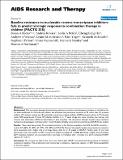| dc.contributor.author | Fiscus, Susan A | |
| dc.contributor.author | Kovacs, Andrea | |
| dc.contributor.author | Petch, Leslie A | |
| dc.contributor.author | Hu, Chengcheng | |
| dc.contributor.author | Wiznia, Andrew A | |
| dc.contributor.author | Mofenson, Lynne M | |
| dc.contributor.author | Yogev, Ram | |
| dc.contributor.author | McIntosh, Kenneth | |
| dc.contributor.author | Pelton, Stephen I | |
| dc.contributor.author | Napravnik, Sonia | |
| dc.contributor.author | Stanley, Kenneth Earl | |
| dc.contributor.author | Nachman, Sharon A | |
| dc.date.accessioned | 2012-01-09T01:09:20Z | |
| dc.date.issued | 2007 | |
| dc.identifier.citation | Fiscus, Susan A, Andrea Kovacs, Leslie A Petch, Chengcheng Hu, Andrew A Wiznia, Lynne M Mofenson, Ram Yogev, Kenneth McIntosh, Stephen I Pelton, Sonia Napravnik, Kenneth Stanley, and Sharon A Nachman. 2007. Baseline resistance to nucleoside reverse transcriptase inhibitors fails to predict virologic response to combination therapy in children (PACTG 338). AIDS Research and Therapy 4: 2. | en_US |
| dc.identifier.issn | 1742-6405 | en_US |
| dc.identifier.uri | http://nrs.harvard.edu/urn-3:HUL.InstRepos:7349730 | |
| dc.description.abstract | Background: The association between baseline drug resistance mutations and subsequent increase in viral failure has not been established for HIV-infected children. We evaluated drug resistance mutations at 39 codon sites (21 protease inhibitor (PI) resistant codons and 18 nucleoside reverse transcriptase inhibitor (NRTI) resistant codons) for 92 clinically stable NRTI-experienced, PI-naive HIV-infected children 2 to 17 years of age who were initiating new therapy with ritonavir plus zidovudine (ZDV) and lamivudine or plus stavudine. The association between baseline drug resistance mutations and subsequent viral failure after 12 and 24 weeks of highly active antiretroviral therapy (HAART) was studied. Results: There were few primary PI associated mutations in this PI-naïve population, but 84% had NRTI mutations – codons 215 (66%), 41 (42%), 67 (37%), 210 (33%) and 70 (32%). None of the specific baseline drug resistance mutations were associated with a higher rate of virologic failure after 12 or 24 weeks of HAART. Median week 12 viral load decreased as the total number of NRTI mutations at baseline increased (P = 0.006). Specifically, a higher level of baseline ZDV resistance mutation was associated with a decrease in viral failure after 12 weeks on a ZDV-containing HAART regimen (P = 0.017). Conclusion: No increase was seen in the rate of viral failure after HAART associated with the presence of resistance mutations at baseline. This paradoxical result may be due to adherence, replicative capacity, or ZDV hypersusceptibility to the new regimen. | en_US |
| dc.language.iso | en_US | en_US |
| dc.publisher | BioMed Central | en_US |
| dc.relation.isversionof | doi://10.1186/1742-6405-4-2 | en_US |
| dc.relation.hasversion | http://www.ncbi.nlm.nih.gov/pmc/articles/PMC1802955/pdf/ | en_US |
| dash.license | LAA | |
| dc.title | Baseline Resistance to Nucleoside Reverse Transcriptase Inhibitors Fails to Predict Virologic Response to Combination Therapy in Children (PACTG 338) | en_US |
| dc.type | Journal Article | en_US |
| dc.description.version | Version of Record | en_US |
| dc.relation.journal | AIDS Research and Therapy | en_US |
| dash.depositing.author | McIntosh, Kenneth | |
| dc.date.available | 2012-01-09T01:09:20Z | |
| dash.affiliation.other | SPH^Immunology and Infectious Diseases | en_US |
| dash.affiliation.other | HMS^Pediatrics-Children's Hospital | en_US |
| dc.identifier.doi | 10.1186/1742-6405-4-2 | * |
| dash.contributor.affiliated | Stanley, Kenneth | |
| dash.contributor.affiliated | McIntosh, Kenneth | |


